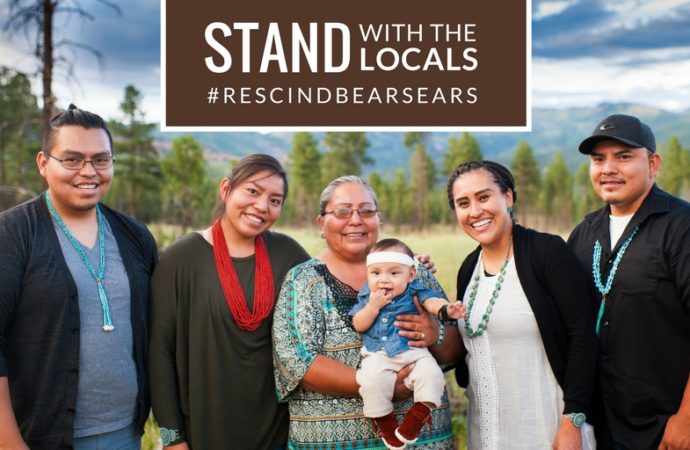President Trump and Secretary of Interior Ryan Zinke have righted a wrong, marking a victory for local voices and fair and just government. After months of meeting and conferring with local residents, tribal leaders, and elected officials, the Trump administration reduced the size of the 1.35 million acre Bears Ears National Monument by 85 percent.
As Matt Anderson and I wrote in The Hill, Bears Ears has been the poster child for national monument abuse.
Prominent in this list of presidential abuses is President Obama’s designation of the 1.35 million-acre Bears Ears National Monument. This remote corner of southeastern Utah is a land of red-rock canyons, towering mesas and ancient cliff dwellings. More impressive than the landscape, however, are the native people who call this place home. Here local Navajos rely on access to these federal lands so they can collect firewood to heat their homes, hunt to feed their families, and graze their livestock to eke out a living.
The December 28, 2016, announcement was a unilateral presidential land grab of an area twice the size of Rhode Island, designating Bears Ears as a “national monument” and drastically altering the lives of those near it without any type of checks and balances on the process…until President Trump and Secretary Zinke.
President Trump’s announcement today demonstrates the administration’s willingness to listen to those who live near and depend upon Bears Ears and the commitment to the original intent of the Antiquities Act.
Congress passed the Antiquities Act in 1906 in response to widespread looting and desecration of Native American historical sites near the turn of the 20th century. The law gave presidents the ability to unilaterally set aside federal lands as national monuments with simply the stroke of a pen. However, within the act is explicit language that national monuments must be confined to “the smallest area compatible with the proper care and management of the objects to be protected.”
Expansive designations like President Obama’s Bears Ears fly in the face of that language, specifically “the smallest area compatible…”
Another abuse is with the morphing of the definition of the term “objects,” which originally meant artifacts and now can mean anything from a view shed to biodiversity. Protecting objects of historical significance was not intended to mean draconian restrictions on access to huge swaths of federal land.
The President also announced a reduction in the size of Grand Staircase-Escalante National Monument. This correction of federal overreach from previous administrations is the result of a first ever formal review of all national monuments over 100,000 acres. Secretary Zinke and his staff at the Department of Interior are to be commended for their commitment to the original intent of Antiquities Act, a good law that has been used to seize millions of acres of land mostly in the Mountain West as Matt and I wrote in August:
If we compare the first eight administrations that utilized the Antiquities Act to create or expand national monuments with the last eight, average acquisitions have been 89 times larger since President Eisenhower took office.
The driving force of this trend of abuse can be attributed to the ulterior motives of big money environmental groups and their corporate allies in the outdoor recreation industry. Instead of focusing on the protection of specific historic, cultural and scientific objects, the modern designation process is now driven by politics, climate change, presidential legacies, corporate interests, and outdoor recreation.
An August 2016 article in the Desert News exposed who was behind the Bears Ears designation movement.
In October 2014, a group of people sat around a table and discussed their campaign to bring a monument designation to southeast Utah for the region they called Bears Ears.
This wasn’t a group of Native American tribal leaders from the Four Corners, but board members from an increasingly successful conservation organization who met in San Francisco to discuss, among other things, if it was wise to “hitch our success to the Navajo.”
Notice the meeting was in San Francisco, not in San Juan County, Utah, where Bears Ears is actually located. Desert News environmental reporter Amy Joi O’Donoghue followed the out-of-state trail and found millions of dollars from environmental left foundations and even Leonardo DiCaprio. As a result, the fight has pitted Utah Navajos and San Juan local residents against big money climate change organizations and out-of-state tribal leaders. Utah’s Sutherland Institute and its Coalition for Self-Government in the West has done an exceptional job telling the story of real grassroots movement to rescind the Bears Ears abusive designation.
None of this happens without the administration’s commitment to a balanced approach to federal lands – an approach that protects our nation’s treasures while reversing past federal overreach, increasing public access to federal lands, and respecting local perspectives and ways of life.
If you have a moment, you might want to send a thank you note to President Trump and Secretary Zinke for doing the right thing. A word of advice, be prepared and keep a fire extinguisher handy to douse the environmental left’s hair-on-fire hysterical, but all too predictable, reaction.









